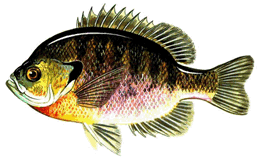Back to Previous Page
BLUEGILL

At-a-Glance
- Scientific Name: Lepomis macrochirus Also known as: Bream
- Found in Illinois: Statewide
- State Average: 5"
- State Record: 3 lbs/8 oz (1987)
- Best Lures: wax worms, red worms, red wigglers, crickets, night crawlers, small minnows, and artificial flies and poppers
Best fishing is often near shorelines, docks, or other structures at depths from the near surface to 3–4 feet.
Light line and tackle are the best to catch more fish and provide the most fun. The favorite live bait is a nightcrawler, while artificial lures, such as leadhead jigs with a twister tail or a grub, can be equally effective. The savvy bluegill fisherman can borrow from the fly-fishing tackle box and use small poppers with a small float (set the float 4 feet from the lure) for added fun.
While males are on the nest, they are aggressive and will strike at any lure or bait that fall into the nest. Be careful though, it is easy to remove a huge number of males from a colony (and their fry will not survive without the protection of a male).
Bluegill are also lots of fun on a fly-rod and an excellent way for the rookie fly-fisherman to gain skills. Bluegill will usually rise to hit poppers, and wet flies or ultra-lite flies will tease them out of deeper areas.
Habitat:
Bluegill can be found across the state of Illinois and are in nearly every water body. Bluegill prefer clear lakes and ponds with adequate aquatic vegetation or other structural features (wood or rocks) to avoid predation by other fish, but can also be found in swamps, creek pools, and small to large rivers. While they prefer warm waters, bluegill will move to deeper, cooler waters when temperatures rise.Adult Bluegill are less susceptible to predation and thus are able to utilize more habitat types and show no preference between vegetated and open water areas.
Feeding and Habits:
Bluegill are classified as generalists and will feed on almost any food source that it can fit in their mouth. Bluegill diets typically consist of aquatic insects and larvae, but can include crayfish, leeches, snails, and worms.
Reproduction:
Like the black bass and other sunfishes, male bluegill build nests and provide parental care. They are a social fish and build their nests in colonies that often include hundreds of nests. The close proximity of nests built in the colony often has honeycomb appearance when viewed from the shore or boat. Males build a nest by clearing the substrate with their caudal fin forming a deep depression. Parental males attract females by rapidly circling their nests and vigorously caudal sweeping their nests, as if to show off their housekeeping skills. When females enter the nest, males will herd her around the nest in a circle, waiting for her to dip on her side to release eggs. The male releases sperm and the sticky eggs fall and adhere to the nest substrate. Females will spawn with a number of different males, so that each nest contains eggs from a variety if individuals. Bluegills will spawn multiple in bouts from spring to mid summer.



